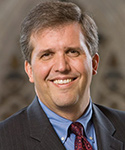The film “Moneyball” makes an argument about baseball applicable beyond America’s pastime.
With no money and the loss of his best players, Oakland A’s general manager Billy Beane discovers a young analyst, Peter Brand, who teaches him to evaluate ballplayers differently. “People are overlooked for a variety of biased reasons and perceived flaws,” Brand tells him. “Age, appearance, personality.”
With a flawed view of talent, managers size up players as total packages rather than in terms of how to win ballgames. “The Boston Red Sox see Johnny Damon,” Brand says, “and they see a star who’s worth seven and a half million dollars a year. When I see Johnny Damon, what I see is … is … an imperfect understanding of where runs come from.”
Allured by flashy talent, managers miss the hidden attributes of players that really lead to wins, or worse, they predict a player’s potential by all the wrong factors.
How often does this happen to institutions looking for new leaders? Search committees want to avoid those candidates who are deceptively alluring yet long-term disasters, but too often they emphasize the wrong criteria, rely on a stunning résumé or become enamored of a charismatic personality. At their worst, they do all three.
Committees need to go deeper to examine the hidden character traits needed for the work of leadership. One trait is perseverance.
Perseverance is a key criterion in actually getting things done, but it’s often invisible on a résumé -- and lacking in people used to getting by on charm rather than character. We obviously look for talent in identifying potential leaders, yet we often fail to recognize the intimate links between talent and perseverance.
Malcolm Gladwell makes this point with the 10,000-hour rule, described in his book “Outliers.” Looking at research conducted by psychologists who study the development of expertise, Gladwell suggests that a person needs to “practice and apprentice” for 10,000 hours (or about 10 years) to become truly great at something. Even a child prodigy such as Mozart doesn’t produce something great until he has trained for 10 years, Gladwell says.
In an interview with Anderson Cooper, he notes significant features of the 10,000-hour rule: it’s astoundingly consistent across fields; it suggests that we often assess individuals’ potential improperly or far too early; and its application has less to do with individualized self-help and more to do with structuring institutions so people can work hard enough and long enough to reach mastery.
These implications are integral to George Anders’ analysis in “The Rare Find: Spotting Exceptional Talent Before Everyone Else .” He notes the critical importance of perseverance among high achievers across an astoundingly wide variety of vocations, from the Army’s Special Forces to Teach for America’s teachers to corporate CEOs to artistic and athletic performers. He also highlights the importance of several indicators of an individual’s perseverance.
The first indicator is resilience -- how a person adjusts and adapts when things go awry or he or she fails at something. Anders reports that Teach for America restructured the way it assesses teacher candidates when it discovered that resilience was far more critical than “classroom charisma” to successful teaching in its program.
Anders says people often miss resilience in their assessment of someone’s leadership capacity, because the traditional business practice of résumé evaluation makes resilience “an almost invisible trait.” It’s TFA’s capacity to stay alert to invisible virtues, like perseverance, that distinguishes its success as an institution.
A second indicator involves paying attention to the particulars of how a person practices.
The virtue of perseverance is not simply a matter of hours logged in routines but of mindful discipline in even the small things. College basketball scouts have learned to notice which players run back to the huddles during a time-out and which ones dawdle. Army Special Forces assessors pay attention to a soldier’s demeanor during a long march.
As Anders observes, “Details count, not because one minor factor holds the key to everything, but because many small impressions will add up to a decisive, accurate judgment.”
A third indicator, Anders notes, is that the best people thrive by being stretched to grow.
People who persevere not only are resilient; they also are hungry for new opportunities that test them over time. They are motivated by an internal drive toward excellence. They are drawn to institutions that set huge goals and have cultures that presume and demand perseverance.
Anders describes these cultures as “coral reefs,” capable of renewing themselves, and they function well only if their leaders are themselves people who thrive by being stretched to grow and thus continually set ambitious goals for themselves and their organizations.
Such an emphasis on perseverance ought to have strong resonance for Christian institutions and their leaders, and for search committees looking not only for the top leadership but for talent throughout the institution. After all, Christians are enjoined to persevere in Romans 5, where Paul links suffering and endurance to the formation of character and the cultivation of hope.
Even more, Christian institutions ought to be cultures that practice resilience. Not only is failure a mark of Christ-shaped leadership and pruning a practice of faithfulness, but Christian practices of forgiveness and reconciliation ought to enable Christian institutions to embody resilience in peculiarly deep and rich ways.
Christian institutions also can and should be coral reefs, renewing themselves with huge goals animated not by self-aggrandizement but by the awe-inspiring character of the God whose gracious love and reign call us to thrive in ways we could not otherwise have imagined.
In Philippians 2, Paul enjoins us to put away “selfish ambition,” but his very use of an adjective suggests that there is a kind of ambition that ought to be cultivated: ambition for the gospel.
Of course, this also calls Christians, and Christian institutions, to pay significantly more attention to how we engage in our practices. Have we cultivated the habits and skills that shape people, and cultures, to be as disciplined as we need to be to persevere? Are we as committed to recognizing that practices -- forgiveness and hospitality, or developing a scriptural imagination for leadership -- take 10,000 hours to really learn, just as a skill like playing the piano does?
“It’s hard not to get romantic about baseball,” Billy Beane says. The same is true for leadership.
Search committees have daunting tasks in identifying leaders of Christian institutions. Learning to ask the right questions, and to design strategies to learn about whether candidates have the trait of perseverance, can go a long way not only toward finding good candidates but also toward cultivating renewing cultures that will enable faithful institutions to thrive.

















